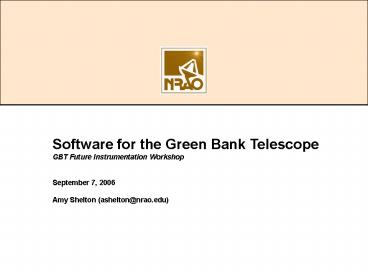Enterprise CRM Solution PowerPoint PPT Presentation
Title: Enterprise CRM Solution
1
Software for the Green Bank Telescope GBT Future
Instrumentation Workshop September 7, 2006 Amy
Shelton (ashelton_at_nrao.edu)
2
Scope Resources
- 8 software engineers, 1 co-op, 1 manager GB and
CV - Control System (incl. new instrumentation),
Observing System, Data Analysis, and RD Support
Operational Support (for observing and data
analysis), Maintenance, New Development - Science Drivers
- Enable high-frequency operation of the telescope
(PTCS project, instrumentation) - Provide capabilities to generate new, unique
science from the GBT - 6-week development cycles in place since 2003
(software only) and since 2004 (site-wide) - New capabilities released after small, iterative
rounds of integration testing (to ensure
integrity of new code within system), regression
testing (to ensure continuity of existing
observational capabilities), and sponsor testing
(scientific validation of new functionality).
3
How is Our Software Organized?
GUIs
Application
Application Component
0..n
uses
HLAPIs
Expert User
Programmer
uses
uses
LLAPIs
Control System
Observed Data (in an EDF)
Real-Time Data (streaming)
4
How is Our Software Organized?
5
The GBT MC System Ygor
- The Ygor system has been designed for control and
monitoring of the many pieces of hardware that
make up the GBT. - Hierarchical Coordinators Managers
- Each device on the GBT has a Manager, i.e. each
receiver, each backend, etc. - Each Manager has control capabilities Parameter
- Each Manager has monitoring capabilities
Sampler - Each Manager produces alarms/messages Message
- Managers can produce engineering FITS files
FitsIO - Ygor API Control and monitor interface to the
telescope as defined by the C classes Panel and
Monitor. - The goal of this interface is to provide
everything an observer needs and most of what an
engineer or operator needs to interact with the
telescope. - Currently accessible directly by C classes
through Panel and Monitor, by Glish's ygor class
(used for debugging only), the enhanced tcl
interpreter segeste (used by engineers and
operators interface), and Grail (used by
observers interface).
6
The GBT MC System Ygor
7
Interface Control Requirements to MC
- There is a programmatic interface to the system.
This interface may be via software protocols such
as class linkage or module or Ethernet
communications. A user interface is not
considered to be a programmatic interface. - All settings (hardware or software) for a scan
are described in a finite set of static
variables, i.e., variables only need to be set
once, prior to a scan. - Synchronous subsystems (subsystems which
internally change state aligned to the start of a
scan) start a scan according to a given time. - Synchronous subsystems can provide their earliest
guaranteed scan start time on demand prior to a
scan, but before acting on the commanded
variables.
8
The Observers Interface AstrID
- The Astronomer's Integrated Desktop (Astrid) is a
single, unified workspace that incorporates, but
does not replace, the suite of applications that
can be used with the GBT. - Observation Management - Observing API, a.k.a.
Turtle - Provides access to source information, antenna
motion, configuration, and IF balancing via
Scheduling Blocks (SBs). - Scheduling Blocks contain an observing script and
project metadata, which allows them to be
archived and managed as descriptions of the
observer's intent. The Observation Management
application component helps you organize your
Scheduling Blocks for a project, select and
submit them to the telescope, and review what
occurred during execution. - Real-time Data Display, a.k.a. GFM
- Provides sub-scan-based display and analysis of
GBT data, either in real-time as the data is
being collected, or in an offline mode where it
can be used to simply step through the sub-scans
from an observation. - GBT Status Display
- Displays various GBT specific parameters, sampled
values and computed values. - Product Page http//wiki.gb.nrao.edu/bin/view/Dat
a/AstronomersIntegratedDesktop
9
The Observers Interface AstrID
10
GBT Data Reduction GBTIDL
- GBTIDL is an interactive package for reduction
and analysis of spectral line data taken with the
Green Bank Telescope (GBT). - The package consists of
- A set of straightforward yet flexible
calibration, averaging, and analysis procedures
(the "GUIDE layer") modeled after the UniPOPS and
CLASS data reduction philosophies, - A customized plotter with many built-in
visualization features - Data I/O and toolbox functionality that can be
used for more advanced tasks. - GBTIDL makes use of data structures which can
also be used to store intermediate results. - Expert users can also access a toolbox of
functions and procedures that operate on a lower
level. Although this seems to happen rarely. - The package consumes and produces data in GBT
SDFITS format. Observers have uncalibrated SDFITS
data available to them at the end of a run. - GBTIDL can be run online, and have access to the
most recent data coming off the telescope, or can
be run offline on preprocessed SDFITS files. - Easily allows user-contributed functionality.
- Product Page http//gbtidl.sourceforge.net
11
GBTIDL GBT Data Reduction
12
Plans for FY2007
- New devices go into service this fall
- Penn Array receiver
- Zpectrometer
- Dynamic Scheduling of GBT time.
- Improvements to SDFITS (our single dish FITS file
production program) - Support enhance of GBTIDL capabilities
- Support for Precision Telescope Control System
(PTCS) project - One major control system upgrade
- Reduce inter-scan latencies
- Unified messaging
- Creation of data streams

